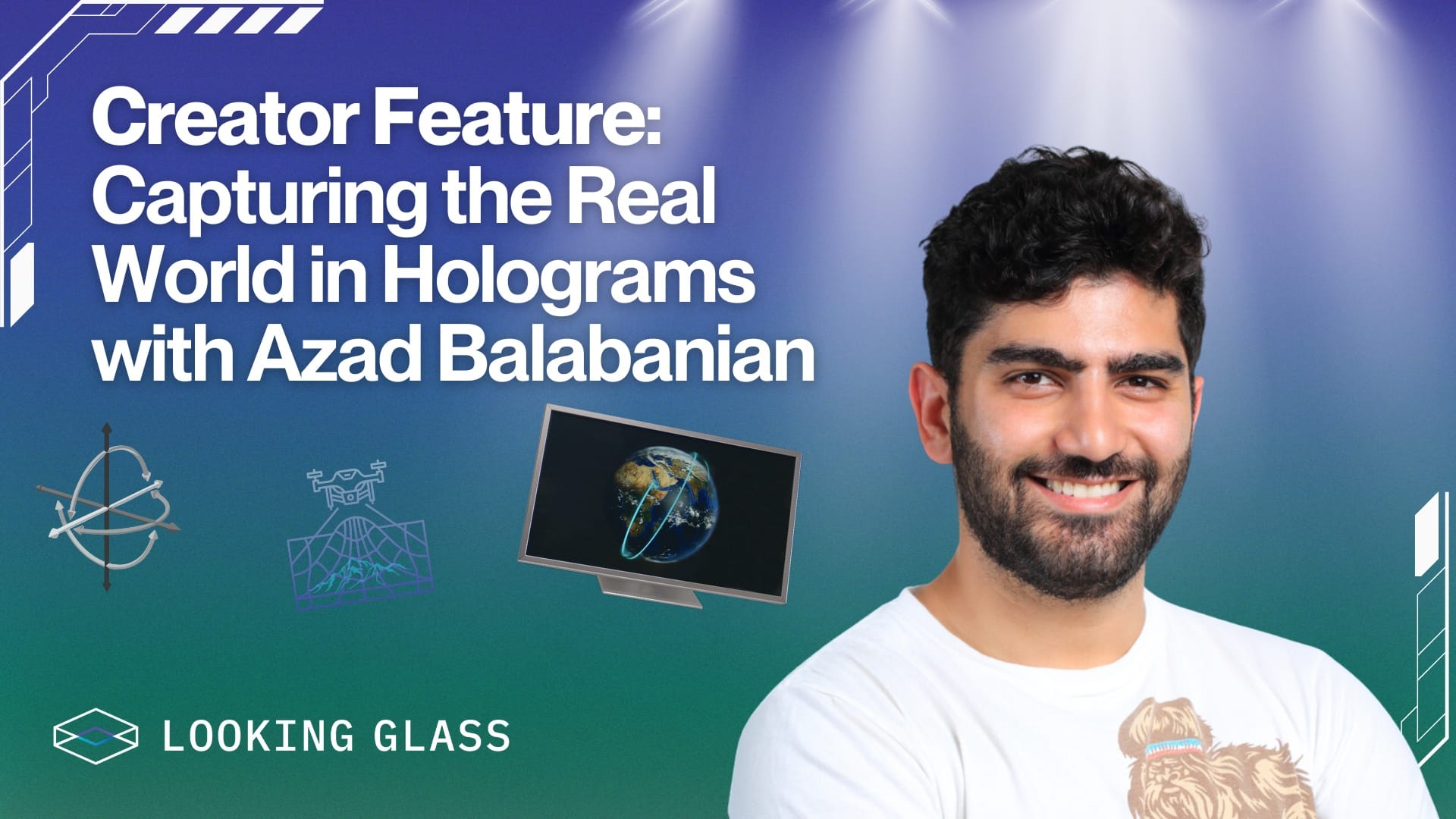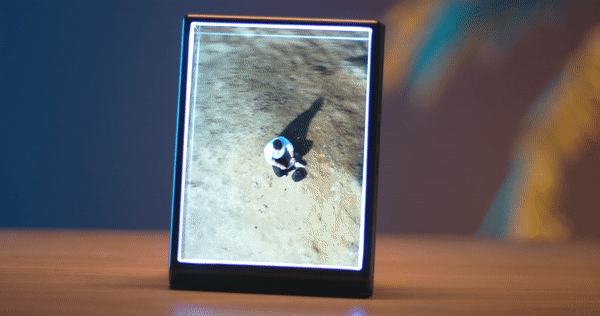Creator Feature: @Azadux Capturing the Real World in Holograms

In this interview, we dive into the world of 3D artist and VR developer Azad Balabanian. From his early inspirations in volumetric video to his current work in pushing the boundaries of photogrammetry and holographic displays, Azad opens up new avenues for creating and showcasing art that transcends traditional flat screens. Driven by a passion for 6DoF (six degrees of freedom) formats and photogrammetry, Azad walks us through his creative journey, the evolving world of volumetric photography, and how Looking Glass has revolutionized how he presents his scans in stunning 3D. His passion for creating immersive, three-dimensional experiences and his innovative use of Looking Glass technology make this a must-read for anyone, whether you’re a creative technologist or just curious about the future of 3D art, or anywhere in between!
p.s. if you want to learn more about real world capture and creating holograms from the world around you for Looking Glass displays, check out our recent article Capturing Real World Holograms for Looking Glass Displays.

Q: Introduce yourself! Who are you, what’s your background and what inspires you?
I’m Azad Balabanian, a 3D artist and VR developer. I’m interested in trailblazing the next generations of photography and cinematography with 6DoF, volumetric formats!
With Looking Glass displays, my dream of showcasing my volumetric work in its native volumetric format is what excites me. Previously, VR was the only way, but with Looking Glass, I can create a little diorama of a real place and showcase it to anyone in the room. It’s truly magical.
Q: Describe your work what are the primary themes you explore through your work? How did you get into 3D and what would you say motivated you to start creating in this field?
I’ve always been enamored by 6DoF as a medium, ever since seeing the OcDoc demo of depth video using an old Xbox 360 Kinect. Seeing that in high school totally blew my mind so it left quite an impression on me.
Later on, while studying in university and working as a research assistant in VR lab, I discovered the medium of photogrammetry, which is a volumetric reconstruction of a space or an object from various photographs.
Over the next few years, I experimented on my own and tried to learn from the best, including David Finsterwalder, who founded the company that I currently work at, realities.io.
Since then, a number of advancements have happened in the field of volumetric photography including NeRFs and Gaussian Splats, which build upon the underlying principles of photogrammetry (structure from motion) and produce an even more photorealistic 6DoF result.
Q: How did you first learn about Looking Glass?
I must’ve first heard of Looking Glass by seeing an old prototype of it at the Institute for the Future in Palo Alto, prior to the 1st Gen LKG displays. Once the dev kits were announced and realized that they are “truly” volumetric (or light fields, as they’re sometimes called), supporting parallax and multi-views natively, I knew this could be the start of a revolutionary type of new display format.

Q: Have you incorporated Looking Glass into your work in any way?
My work, being volumetric photography, I’m always on the hunt to find native 3D mediums. I can create various things with my photogrammetry works (or scans, as I call them) including VR scenes, 3D prints, stereographs and spatial videos, as well as holograms in Looking Glass.
The beauty of the Looking Glass displays are that they are truly native, meaning, they do project all the various views of a 3D scene all at once, supporting parallax natively and without any tricks like head tracking. This also means that multiple people can view a LKG together! It just feels like a truly futuristic device and always impresses the people who see it on my desk.
I love using it as a digital frame, sitting on a shelf, cycling through my various scans, essentially creating little dioramas of beautiful places around the world in my room.
Q: How has the Looking Glass display influenced or changed your creative process?
I think the fact that there are now native holographic displays is immense. It’s something I’ve been hoping and waiting for for a long time. It means that I don’t have to just stick to 2D renders of my 3D scans, but I can actually showcase them as they were intended!
It’s basically the start of the next generation of photography and art. 3D in its native medium.
Q: If you’ve made anything for Looking Glass, what has been your favorite project or piece to create with the Looking Glass, and why?
Apart from my photogrammetry work, I’m a big fan of using drones for capturing new perspectives. I discovered a method of capturing a 3D video using a single drone which was very exciting to me as a fan of stereography, but the excitement escalated when I realized that, with the same method, I can create a light field array, meaning, I can create holographic photo and video to be showcased in the Looking Glass. I can even adjust the amount of depth for each shot by adjusting the gap between each frame, so I have full creative control.
When LKG launched the Blocks product, I quickly incorporated my work into it and hosted it on my website. It’s great that it supports all the out various platforms, like 2D, 3D, and volumetric.
Q: If you’ve shown your work in a Looking Glass publicly, how do viewers typically respond to your work in holographic form? Is there a memorable reaction you could share?
Especially the 1st gen LKG’s with the big chunk of glass, that one always is super eye-catching and gets people to ask me, "what the hell is that?" Once I pull up one of my scans on it, they’re just mind-blown.
I think the most impressive thing is the large scale LKG display (the 8k) where, you really can see the size and scale of the 3D content that is being displayed there. It just feels like a peek into the future.
Q: What advice would you give to other creators considering the Looking Glass for their work but haven't taken the leap to try it yet?
One aspect that will feel new to most new people is that they need to consider the focal point of their object or scene. It’s not a new concept for stereographers but for typical 3D artists and photographers, it is. It’s closely related to depth of field, however, it’s a bit more exaggerated in holographic displays. Typically things in the far backgrounds of LKG scenes are soft and blurred, where as that’s not always the case with 2D renders. You can, of course experiment with that by “flattening” the scene across the Z axis to achieve a 2.5D like format, which can work depending on what you’re trying to do. But yes, there’s lots to learn when experimenting with new holographic displays.
Q: How has the Looking Glass community contributed to your experience as a creator?
There are some brilliant people in the LKG community which makes a HUGE difference when you’re looking for help. It’s always felt like LKG has done a great job in fostering a strong community which has attracted people to spend time to build tools, documentation, and technology around the LKG displays.
The Discord server has been helpful for finding out new things about the displays, finding help from users, and meeting like minded folk.
Building a strong community for a platform is a very, very underrated aspect of product development, and I’m really happy to see how successful LKG been at it. It’s for the benefit of all its users!
Q: What does a day in the life of Azad look like?
Wake up, kiss the wife, make coffee, log in to our office Discord voice chat server to greet my coworkers in Berlin, and get to work.
When it comes to free time when I can explore the things that are on my mind, I like to take my camera and drone, go to a new part of the city, and start to walk around. After a few hours, I come back home with 5-10 different scanning projects. I batch process them and see which ones are worth pursuing. If it’s a photogrammetry scan, I do some mesh and texture cleanup in Blender. If it’s a radiance field (NeRF or Gaussian Splat), I begin the scene training with the input photos and clean up unwanted “floaters” and export the end result.
In terms of showcasing the work, if I’d like to create a LKG quilt, I import my scans or splats into Blender, set up lighting and a backdrop (like a real photography studio), pose my work, and render.
Q: What are some other 3D tools (software/hardware) that are in your toolset?
PostShot has been a major innovation in the space of radiance fields because it provides a proper GUI for training NeRFs and Gaussian Splats. Up until now, it’s all been CLI based. I highly recommend it.
RealityCapture is my preferred choice of photogrammetry processing software as it’s the most efficient at processing and creates very high quality results.
As for 3D editors, even though I’m a daily Blender user, there are still tabs in the software that I haven’t even touched. Slowly learning more and more of what it can do!
I wish there were more 3D modeling tools in VR as there once were, but Oculus Medium on the Meta Quest Link app on PC’s is still accessible and free. It’s fantastic.
Q: Where can readers find more of your work or follow your work?
You can find my LKG-specific work on this page! It’s only a limited number of Blocks, but they’re quite cool to look at in the LKG or in VR!
My larger body of photogrammetry work can be found on my Sketchfab, where you can also see them in 3D by downloading them or viewing them via WebXR.
I am a big fan of stereography as well and I’ve made a few aerial 3D short films which you can watch on YouTube.
If you’d like to see how these things get made, follow me on Twitter where I provide a lot of commentary and behind-the-scenes.
And for good measure, @Azadux on Instagram!
Huge thank you to Azad for taking the time to share his incredible insights; We hope you're enjoying our creator features!
Are you a creator working with Looking Glass and want to share your work with us? Write to us at future@lookingglassfactory.com or send us a DM on our Instagram.
We want to shine a light on all the amazing ways creators are using holography to break new ground in the world of digital art!
To the future!
